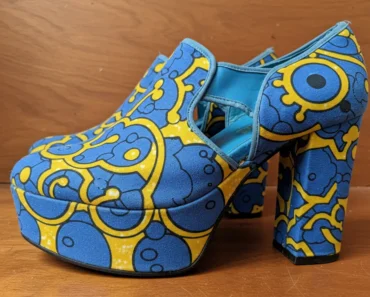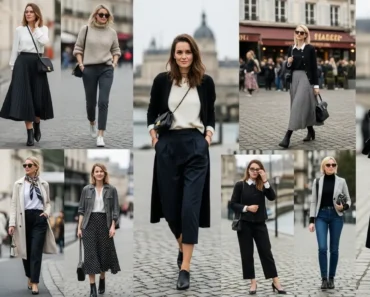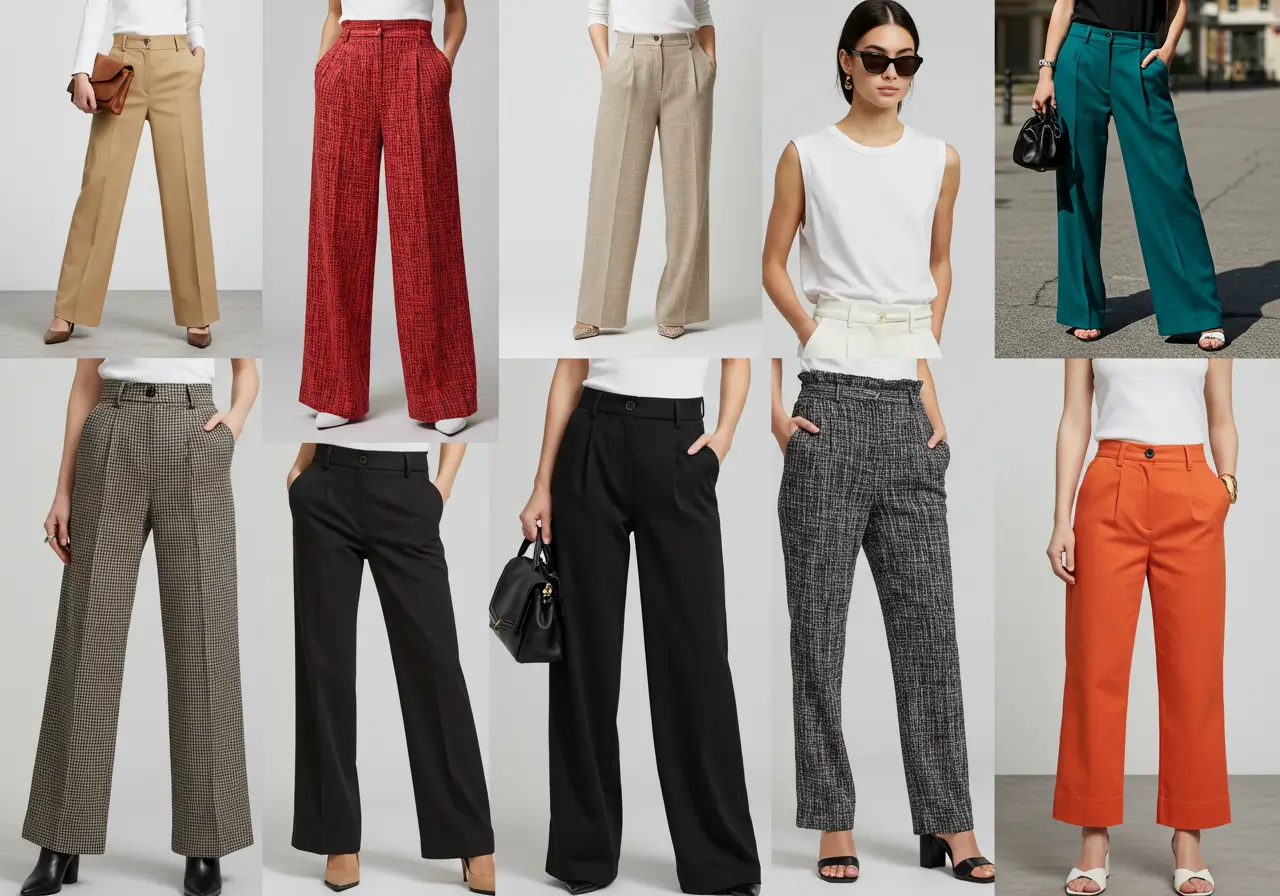This guide delves into the significant role footwear plays in defining and expressing personal style, specifically within the UK context. We will explore how different shoe categories function within a typical British wardrobe, considering both practicality and aesthetics. We will examine how current Shoe Trends intersect with timeless staples, and how specific footwear choices align with various personal style aesthetics.
Furthermore, we will offer practical advice on building a versatile, functional, and expressive footwear collection that resonates with your identity and meets the demands of life in the UK. Understanding the nuances of footwear fashion UK specific allows you to make more conscious, confident choices, ensuring your shoes not only carry you through your day but also step forward as authentic extensions of your personal style.
Why Footwear Speaks Volumes: The Foundation of Style
Often considered the finishing touch, footwear paradoxically serves as a foundation for personal style. The shoes you choose can instantly alter the perception of an entire outfit and reveal much about your approach to fashion and life.
Setting the Tone: Formality and Intent
Shoes have an unparalleled ability to dictate the overall formality and intention of an outfit. The same pair of dark wash jeans can look entirely different depending on whether they are paired with:
-
Crisp White Trainers: Suggests a casual, modern, perhaps slightly sporty or minimalist vibe.
-
Classic Leather Loafers: Implies a smarter, preppy, or classic aesthetic, suitable for smart-casual settings.
-
Chunky Combat Boots: Conveys an edgier, more rebellious, or utilitarian style.
-
Elegant Heeled Ankle Boots: Elevates the look for evening or dressier daytime occasions.
The footwear choice anchors the outfit and signals the wearer’s intent for the occasion, whether it’s comfort, professionalism, trend-consciousness, or practical readiness.
Expressing Personality and Mood
Beyond formality, shoes are potent vehicles for self-expression. Are you someone who prioritises comfort above all else? Your footwear might lean towards practical trainers or supportive flats. Do you embrace bold statements? Perhaps colourful heels or unique, architectural shoe designs are your signature. Are you drawn to heritage and craftsmanship? Classic brogues or well-worn leather boots might dominate your collection. Your shoe choices communicate aspects of your personality – practical, playful, sophisticated, adventurous, traditional, non-conformist – often more immediately than other garments. They can also reflect your mood on a given day; reaching for comfortable flats versus power heels sends different signals, both internally and externally.
Impact on Posture, Confidence, and Demeanour
The physical structure of footwear directly influences how we stand, walk, and carry ourselves. Heels alter posture and gait, often creating a sense of height and confidence (though potentially sacrificing comfort). Sturdy, supportive shoes can encourage a more grounded, purposeful stride. Feeling physically comfortable and secure in your footwear translates into greater overall confidence and ease. Conversely, ill-fitting or inappropriate shoes can lead to discomfort, self-consciousness, and a hesitant demeanour, undermining even the most carefully chosen outfit.
The First and Last Impression
Shoes are often one of the first things people notice (consciously or subconsciously) when forming an impression, and they are also the final element grounding your look. Well-maintained, appropriate footwear signals attention to detail and self-respect. Scuffed, dirty, or contextually inappropriate shoes can detract from an otherwise polished appearance, suggesting carelessness or a lack of awareness. In many professional and social contexts, footwear choices contribute significantly to perceptions of competence, status, and personal care.
The UK Footwear Context: Practicality Meets Personality
When discussing footwear fashion UK based, it is impossible to ignore the specific environmental and cultural factors that shape our choices. British style often reflects a pragmatic approach, blending fashion with the realities of life on the island.
Factor 1: The Great British Weather
This is the dominant influence. Rain, drizzle, puddles, wind, and rapidly changing temperatures are constants. This necessitates:
-
Water Resistance: A significant portion of any UK footwear collection needs to offer some level of protection against wet conditions. Leather treated with protector sprays, materials like waxed canvas, rubber (hello, wellies!), and technical waterproof membranes are highly valued.
-
Durable Soles: Good grip is essential for navigating wet pavements, potentially icy conditions, or uneven surfaces during country walks. Rubber lug soles or commando soles are practical features found on many popular UK boot and shoe styles.
-
Coverage: Ankle boots and closed-toe shoes are staples for much of the year, offering more protection than open sandals or delicate flats.
-
Seasonality: While some footwear works year-round (trainers, loafers), distinct seasonal choices are necessary – sturdy boots for winter, breathable options for the rare warm spells.
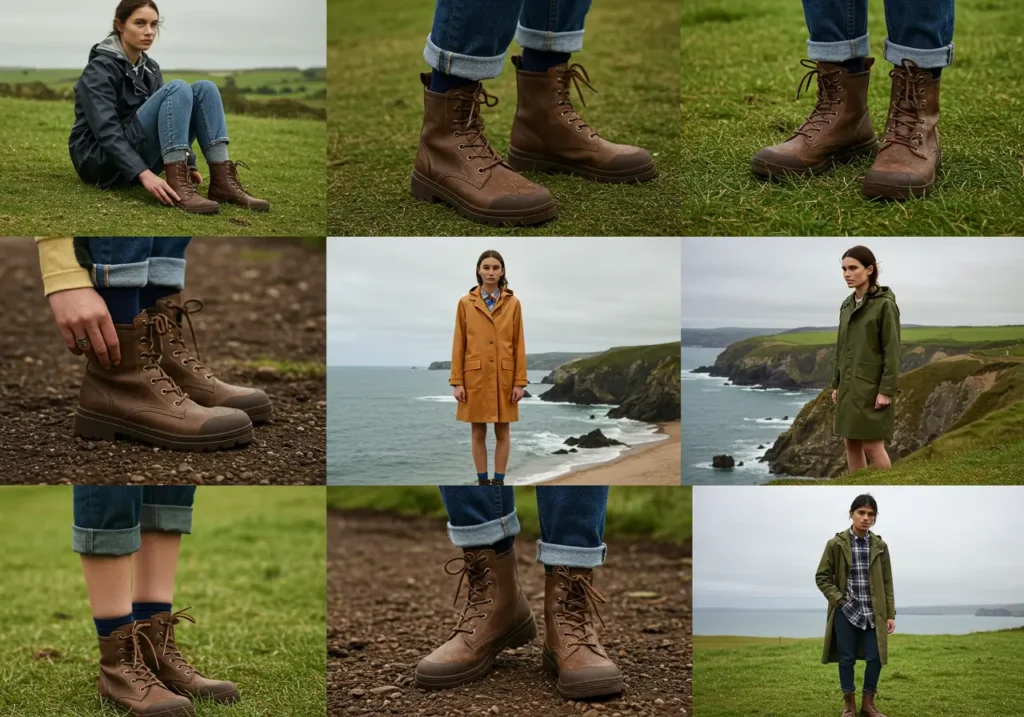
Factor 2: Lifestyle Demands (Urban vs. Rural, Commuting)
The way people live and move around the UK impacts footwear needs:
-
Walking & Commuting: Many UK residents rely on walking and public transport, especially in cities. Comfort and durability are paramount. Shoes need to withstand pavement pounding and potentially crowded commutes.
-
City vs. Country: Footwear needs differ significantly between urban and rural environments. City dwellers might prioritise styles that transition from commute to office, while rural residents need robust options for muddy paths and fields alongside their everyday shoes.
-
Versatility: Shoes that can handle multiple situations – a smart trainer for casual Fridays and weekends, an ankle boot for work and evenings – are highly prized for efficiency.
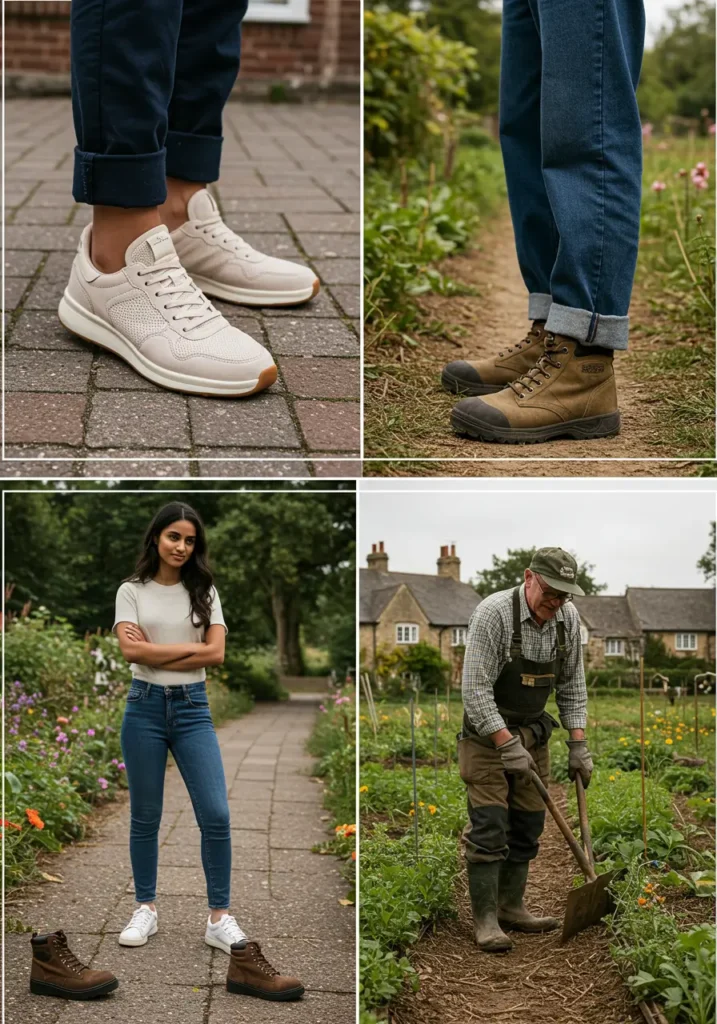
Factor 3: Rich Heritage and Subcultural Significance
UK footwear fashion UK is steeped in history and cultural identity. Certain styles carry significant weight:
-
Iconic British Brands: Brands like Dr. Martens (subculture, durability), Clarks (comfort, heritage – Desert Boot, Wallabee), Grenson, Tricker’s, Church’s (classic Goodyear-welted brogues and boots), Hunter (Wellington boots) are deeply ingrained in the UK style psyche.
-
Subcultural Adoption: Styles like Dr. Martens boots (punk, ska, grunge), loafers (mods), specific trainer models (casuals, grime) have strong associations with youth movements and musical genres, adding layers of meaning beyond pure fashion.
-
Appreciation for Craftsmanship: There’s an enduring respect for traditional British shoemaking techniques like Goodyear welting, valuing longevity and quality.

Factor 4: Trend Absorption and Adaptation
While practicalities are key, the UK is also a major fashion hub, quick to absorb and reinterpret global Shoe Trends. London Fashion Week influences styles, and UK street style often puts a unique, sometimes edgier or more eclectic, spin on current footwear fashions. Trends are often adapted to suit the weather and lifestyle – for example, a delicate shoe trend might be reinterpreted in a sturdier boot form.
Understanding this blend of practicality, heritage, and trend awareness is crucial for navigating footwear fashion UK authentically.
Key Footwear Categories Defining UK Style
Within this context, certain categories of footwear emerge as particularly important or prevalent in the UK. Building your personal style involves selecting versions of these staples that resonate with you.
1. The Indispensable Boot: A Year-Round Necessity
Boots are arguably the most crucial footwear category for UK life, offering protection, durability, and immense style versatility.
The Versatile Ankle Boot
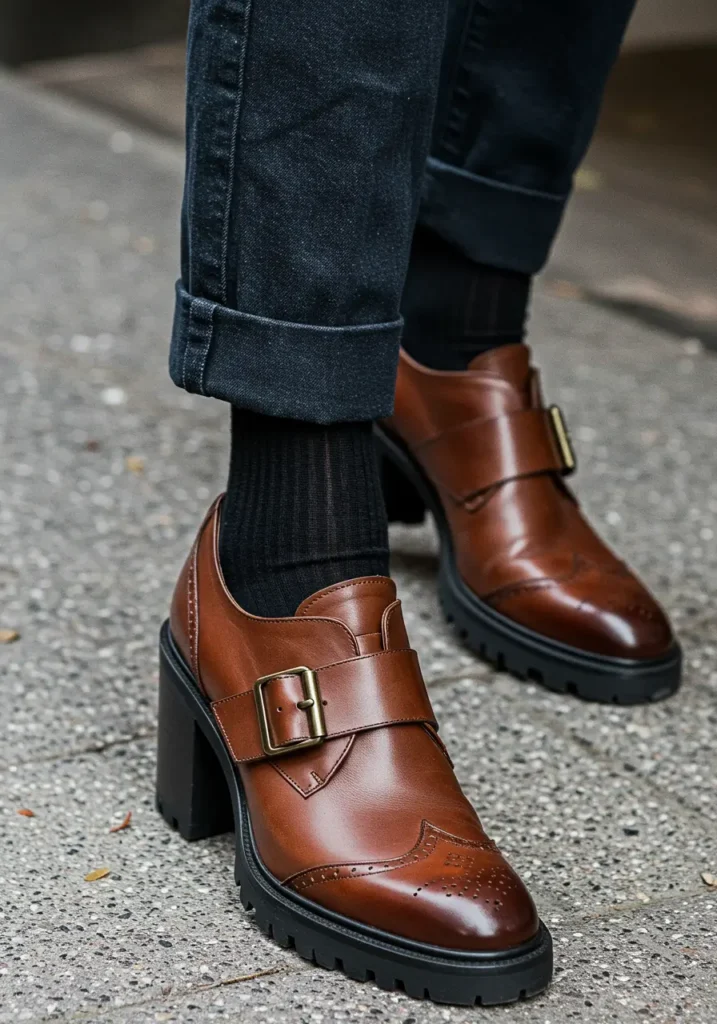
-
UK Relevance: The workhorse of the UK shoe closet. Handles variable weather, suitable for countless occasions, pairs with jeans, trousers, skirts, and dresses. Essential for autumn, winter, and spring.
-
Key Styles:
-
Chelsea Boot: Timeless, easy slip-on design with elastic panels. Ranges from sleek leather for smart looks to rugged suede or chunky soles for casual wear.
-
Lace-Up Boot: Offers adjustable fit and can range from refined dress boots to sturdy combat or work boot styles. Provides good ankle support.
-
Zip Ankle Boot: Often features a block heel, providing a clean silhouette that works well for smarter occasions.
-
-
Styling: Pair with everything from tailored work trousers to weekend jeans and midi dresses (often with tights in cooler weather).
-
Personal Style Link: Sleek black Chelsea = minimalist/classic. Suede desert boot = relaxed/heritage. Chunky combat boot = edgy/utilitarian.
The Knee-High Boot
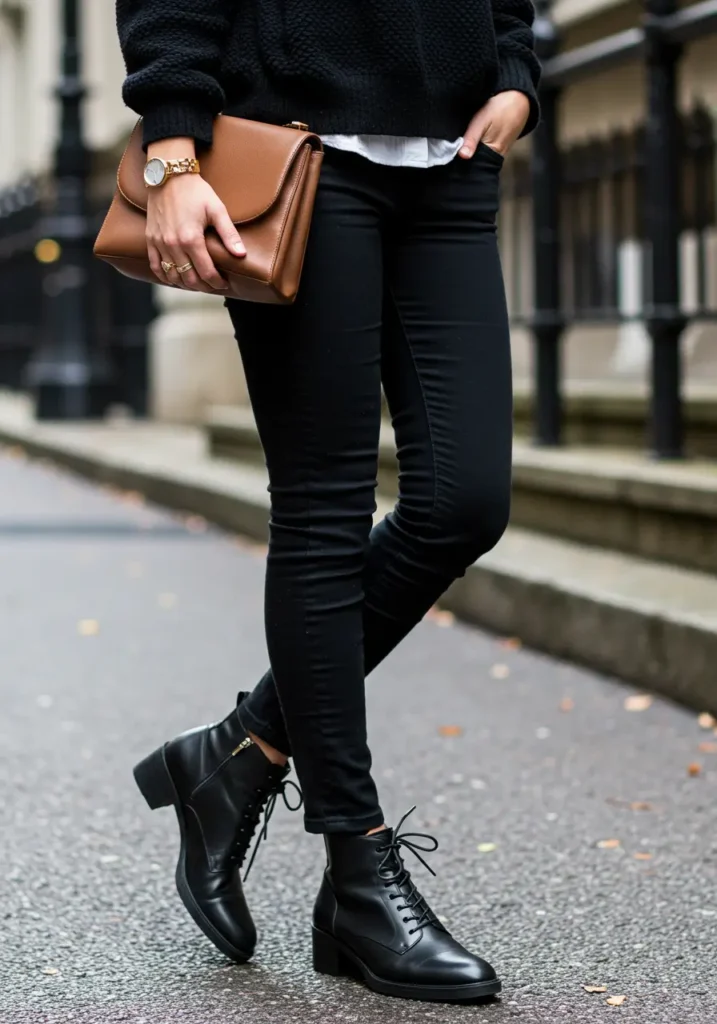
-
UK Relevance: Offers extra warmth and coverage for colder months. Creates a polished, often dressier silhouette. Works well with skirts and dresses, providing coverage for legs when worn with or without tights. Can also be worn over slim-fit jeans.
-
Key Styles:
-
Riding Boot Style: Flat or low heel, classic equestrian look, often in brown or black leather. Timeless and practical.
-
Heeled Knee-High Boot: More elegant, suitable for evenings or smarter daytime looks, often in leather or suede with block or stiletto heels.
-
Slouchy Styles: Offer a more relaxed, bohemian vibe (trend dependent).
-
-
Styling: Pair with midi skirts/dresses, shorter skirts with tights, or over skinny jeans. Provides a sleek line under long coats.
-
Personal Style Link: Classic leather riding boots = preppy/country heritage. Black suede heeled boots = sophisticated/chic. Slouchy boots = bohemian/70s inspired.
The Sturdy/Walking Boot
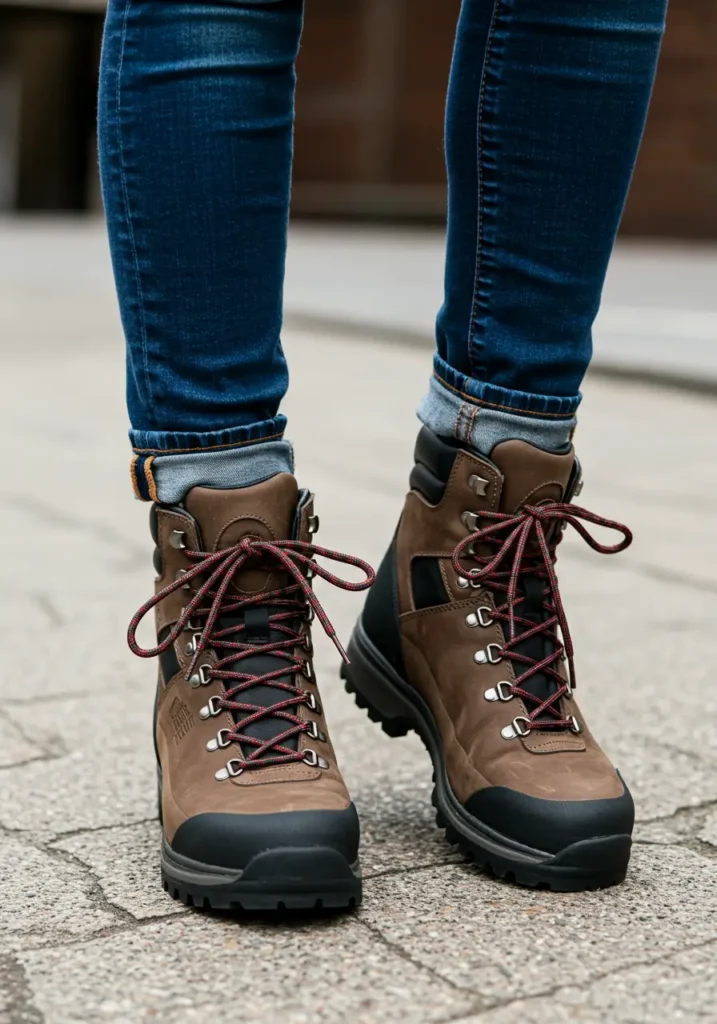
-
UK Relevance: Essential for anyone enjoying the British countryside, parks, festivals, or simply needing robust footwear for very wet or muddy conditions. Prioritises function but style options have improved vastly.
-
Key Styles:
-
Hiking Boot Style: Technical features, ankle support, waterproof membranes, lug soles. Increasingly worn as a fashion statement (Gorpcore trend).
-
Work Boot Style (e.g., Timberland-esque): Durable, often waterproof, rugged aesthetic.
-
Leather Walking Boots: More traditional appearance, durable and comfortable for long walks.
-
-
Styling: Primarily functional wear with outdoor clothing, jeans, or practical trousers. Fashion hiking boots are sometimes styled ironically with dresses or smarter casual wear.
-
Personal Style Link: Reflects an active lifestyle or adoption of utilitarian/Gorpcore trends. Choice of brand and colour adds nuance.
The Iconic Dr. Martens Boot
![]()
-
UK Relevance: Transcends function to become a cultural icon. Represents durability, rebellion, and various subcultures (punk, ska, grunge, goth). Instantly recognisable and enduringly popular across generations. The classic 1460 8-eye boot is a staple.
-
Key Styles: 1460 boot, 1461 shoe, Chelsea boot variations, platform soles. Available in classic black, oxblood, white, and numerous colours and finishes.
-
Styling: Incredibly versatile despite their strong identity. Worn with jeans, dresses, skirts, suits – often used to add an edgy contrast to more feminine or formal outfits. A festival essential.
-
Personal Style Link: Signals connection to alternative subcultures, a non-conformist attitude, or simply an appreciation for durable, iconic design. Platform versions align with current chunky Shoe Trends.
2. The Ubiquitous Trainer: Comfort Meets Cool
Trainers (sneakers in US English, but ‘trainers’ is the dominant UK term) have evolved from purely athletic wear to a cornerstone of everyday footwear fashion UK.
The Classic White Trainer
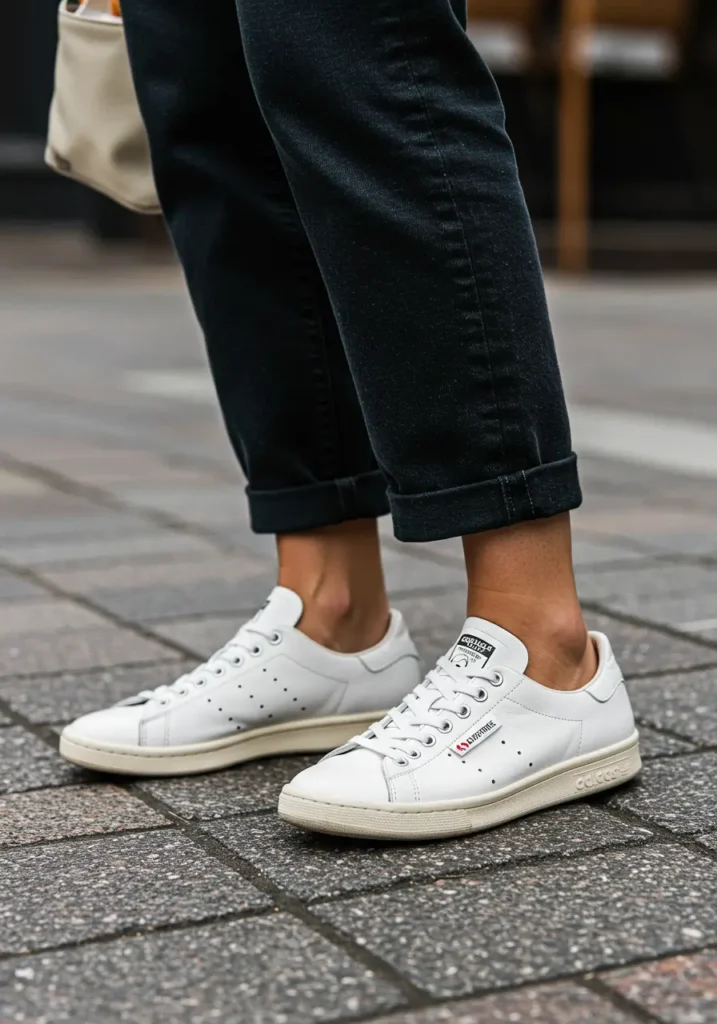
-
UK Relevance: A modern essential providing comfort for walking and commuting while looking effortlessly stylish. Pairs surprisingly well with smarter outfits for a contemporary high-low look common in UK cities.
-
Key Styles: Minimalist leather or vegan leather designs (e.g., Stan Smith, Common Projects style, Vejas), classic canvas (e.g., Superga, Converse Chuck Taylor – low or high top). Cleanliness is key to maintaining the chic look.
-
Styling: Worn with jeans, chinos, wide-leg trousers, midi skirts, dresses. A go-to for casual weekends, travel, and increasingly acceptable in relaxed office environments.
-
Personal Style Link: Minimalist, classic, sporty, casual-chic. The specific model chosen (sleek vs. slightly retro) adds nuance.
Performance & Fashion Trainers
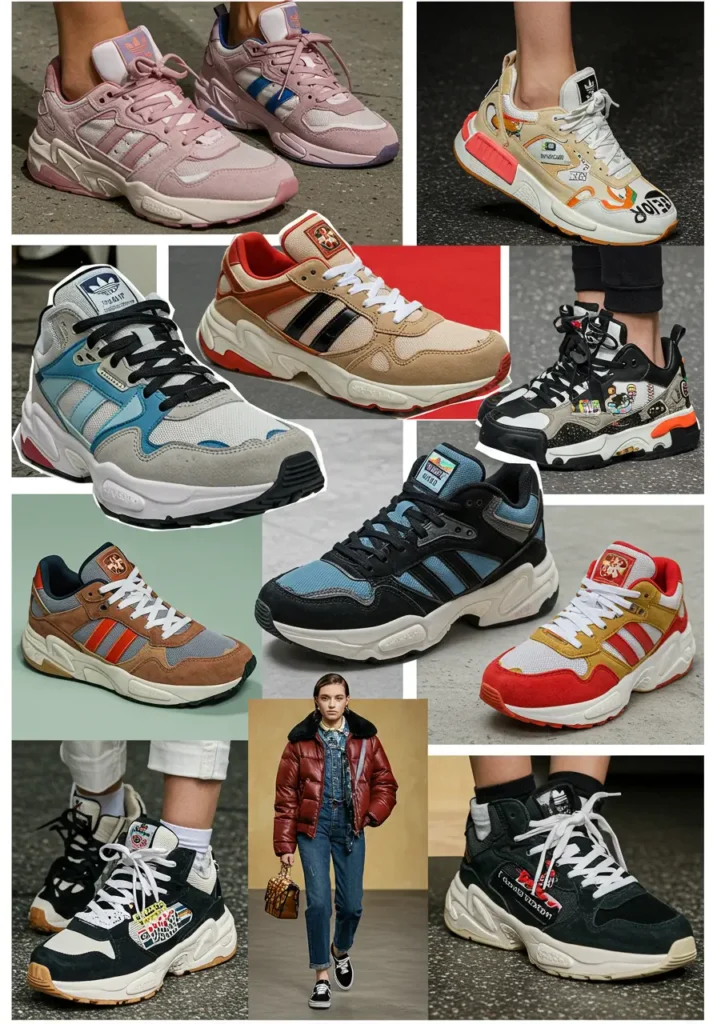
-
UK Relevance: Reflects the global athleisure trend and the UK’s strong sportswear culture. Brands like Nike, Adidas, New Balance are huge. Combines technical comfort with fashion-forward designs. Influenced heavily by current Shoe Trends.
-
Key Styles: Running-inspired silhouettes, chunky “dad trainers,” colourful designs, brand collaborations. Trends shift quickly here.
-
Styling: Worn for both athletic purposes and as fashion statements with casual wear (jeans, joggers, leggings) or even contrasted with dresses or tailoring for an edgier look.
-
Personal Style Link: Sporty, streetwear-influenced, trend-conscious, comfort-focused. Brand choices often signal specific affiliations.
Retro Trainer Styles
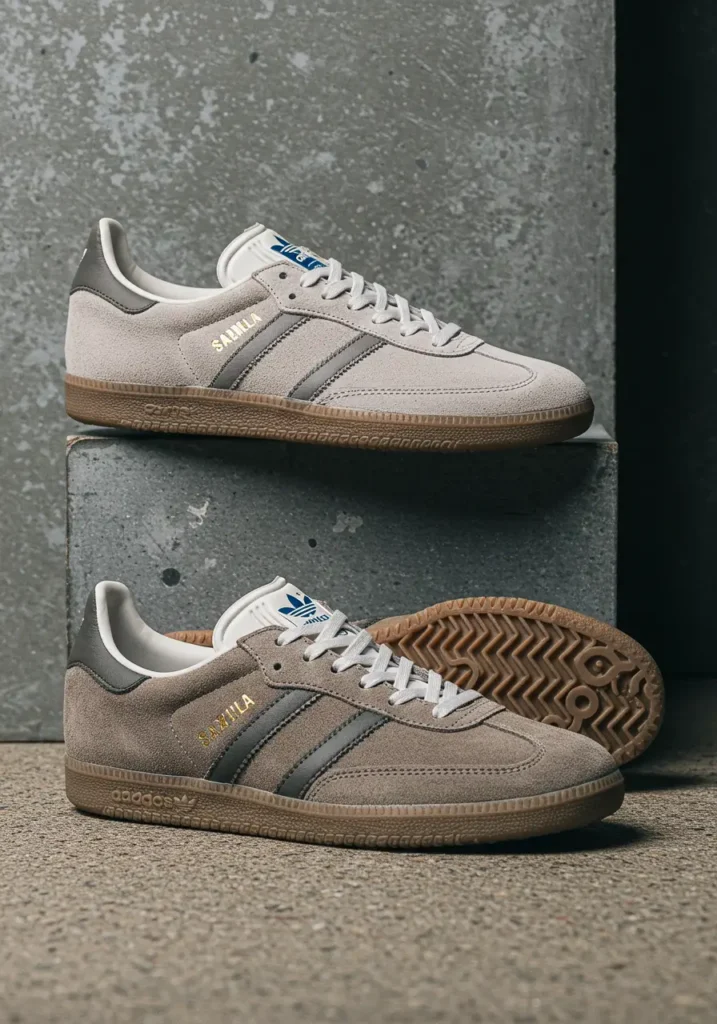
-
UK Relevance: Ties into nostalgia and the influence of past UK subcultures (e.g., Adidas Sambas, Gazelles associated with terrace casuals and Britpop). Offers a more subdued or heritage alternative to hyper-modern fashion trainers.
-
Key Styles: Reissues of classic models from the 70s, 80s, and 90s (e.g., Adidas Samba/Gazelle/Spezial, Nike Cortez, New Balance 574, Reebok Classic). Often feature suede and simpler designs.
-
Styling: Pair well with jeans, chinos, casual skirts. Offer a slightly vintage or understated cool compared to bright white or chunky styles.
-
Personal Style Link: Vintage-inspired, casual classic, links to specific subcultural aesthetics.
3. Smart Flats & Loafers: Polished Practicality
For situations requiring more polish than trainers but more comfort or practicality than heels, smart flats are essential in the UK.
The Loafer
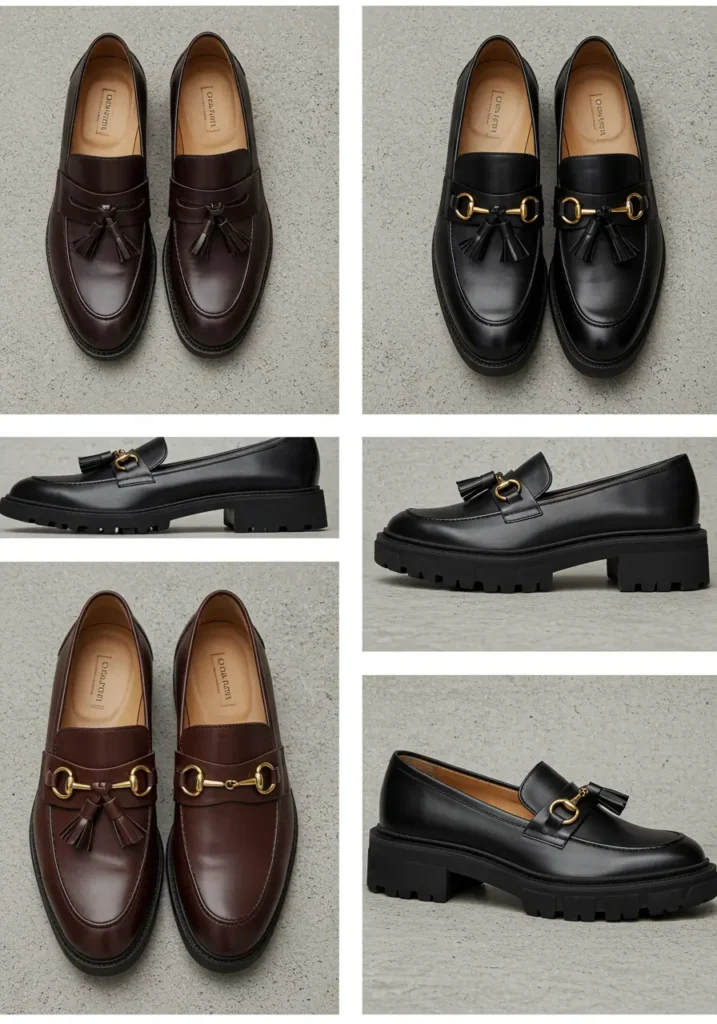
-
UK Relevance: A timeless classic with roots in preppy and mod subcultures. Offers a smart, polished look without a heel. Comfortable for commuting. Works for office wear, smart-casual weekends, and transitional seasons.
-
Key Styles: Penny loafer (classic preppy), tassel loafer (slightly dressier), horsebit loafer (Gucci-inspired elegance), chunky lug-sole loafer (modern trend). Materials range from classic leather (black, brown, oxblood) to suede or patent.
-
Styling: Pair with tailored trousers, chinos, jeans (especially cropped or straight-leg), skirts (A-line, pleated), and dresses. Can be worn with or without socks (thin socks or ankle socks often preferred in UK).
-
Personal Style Link: Classic, preppy, intellectual, menswear-inspired, chic. Chunky versions add a modern, trendy edge.
The Brogue / Oxford Shoe
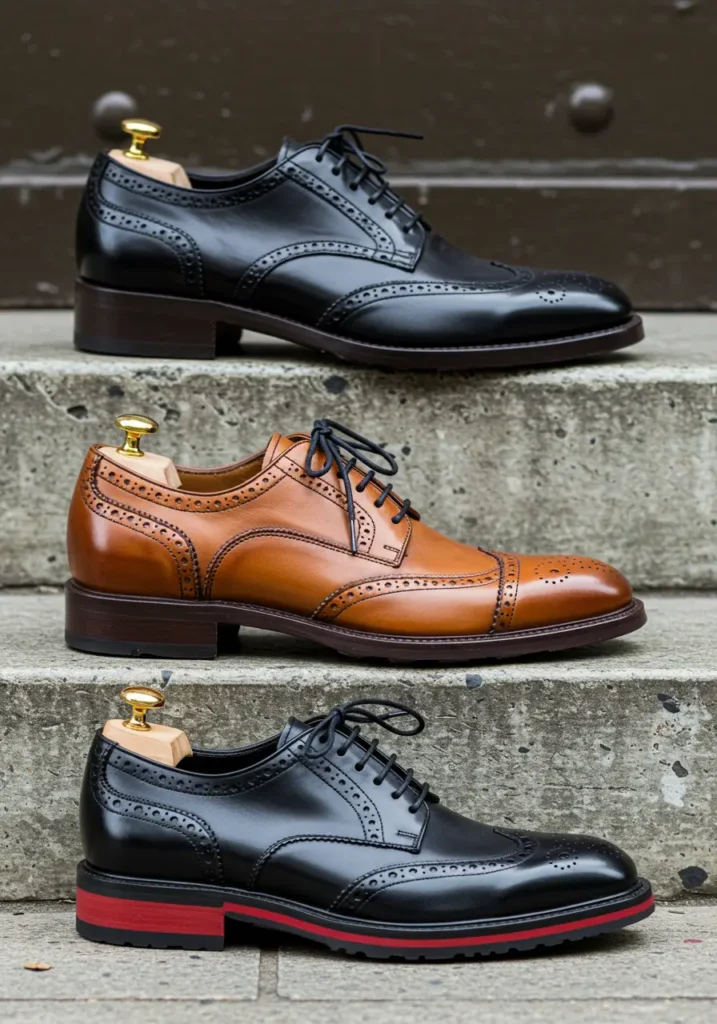
-
UK Relevance: Reflects Britain’s heritage in traditional shoemaking. Offers a formal or smart-casual option with sturdy construction. Often Goodyear-welted for durability. More common in menswear but stylish options exist for womenswear, often borrowed from menswear aesthetics.
-
Key Styles: Oxford (closed lacing, more formal), Derby/Blucher (open lacing, slightly less formal), Brogue (decorative perforations – full brogue/wingtip, semi-brogue, quarter-brogue). Usually in leather (black, brown, tan, oxblood). Chunky or coloured soles offer modern twists.
-
Styling: Traditionally paired with tailoring (suits, smart trousers). Can be worn with jeans or chinos for a smart heritage look. Adds a grounded, slightly academic or dandyish feel to outfits.
-
Personal Style Link: Traditional, classic, heritage, academic, dandy, menswear-inspired.
Ballet Flats & Pointed Flats
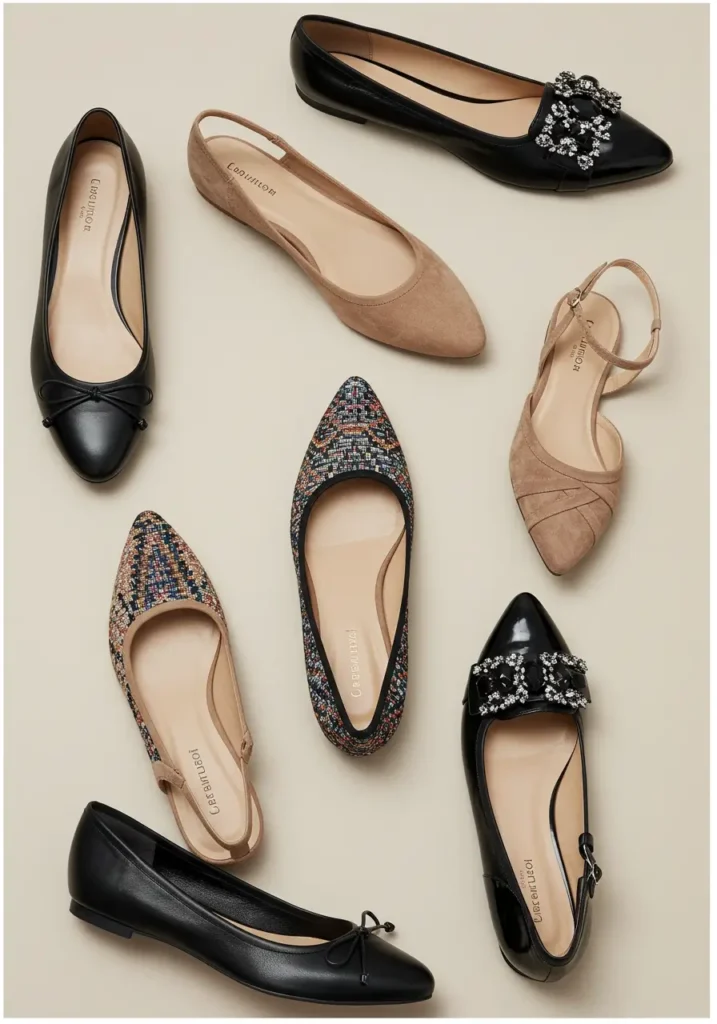
-
UK Relevance: Offer a feminine alternative to loafers or trainers for smarter occasions or office wear when heels aren’t desired. Pointed styles often feel more modern and elongating than rounded toes. Easy to slip on and often packable. Less practical for very wet weather or extensive walking compared to loafers or boots.
-
Key Styles: Classic rounded ballet flat, modern pointed-toe flat, slingback variations, versions with ankle straps or embellishments. Materials include leather, suede, patent, fabric.
-
Styling: Pair well with dresses, skirts, cropped trousers, slim-fit jeans. Offer a polished finish for workwear or smart-casual looks.
-
Personal Style Link: Feminine, classic, chic, minimalist (pointed flats). Can feel Audrey Hepburn-esque or Parisian chic.
4. Heels: Navigating Height with UK Practicality
While perhaps less of an everyday staple for many UK lifestyles compared to flats or boots, heels still play a role for specific occasions and professions.
The Block Heel
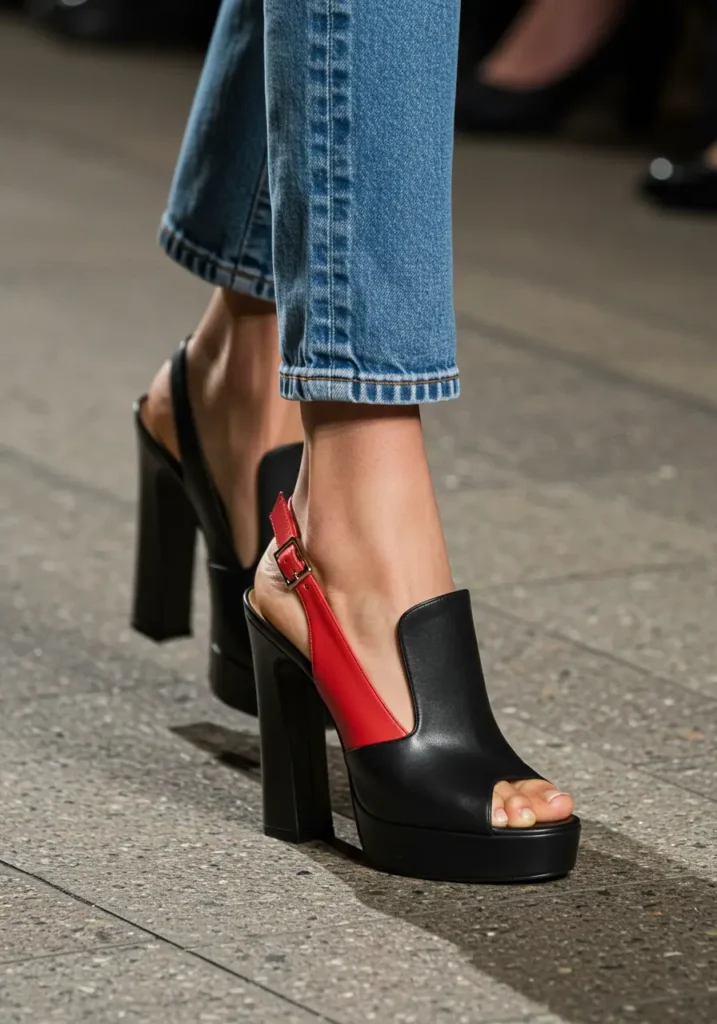
-
UK Relevance: The hero heel for UK practicality. Offers height and elegance but with greater stability and comfort than stilettos, making them more suitable for walking on uneven pavements or standing for longer periods. Widely accepted for work and social occasions.
-
Key Styles: Found on pumps (court shoes), ankle boots, sandals, slingbacks. Heel shape can be chunky, flared, or sculpted. Height varies from low to high.
-
Styling: Extremely versatile. Block heel pumps for work, block heel sandals for summer events, block heel boots for year-round smart looks. Offers a modern yet comfortable way to wear heels.
-
Personal Style Link: Modern, chic, practical-yet-polished. Can be minimalist or statement depending on design.
Stilettos & Occasion Heels
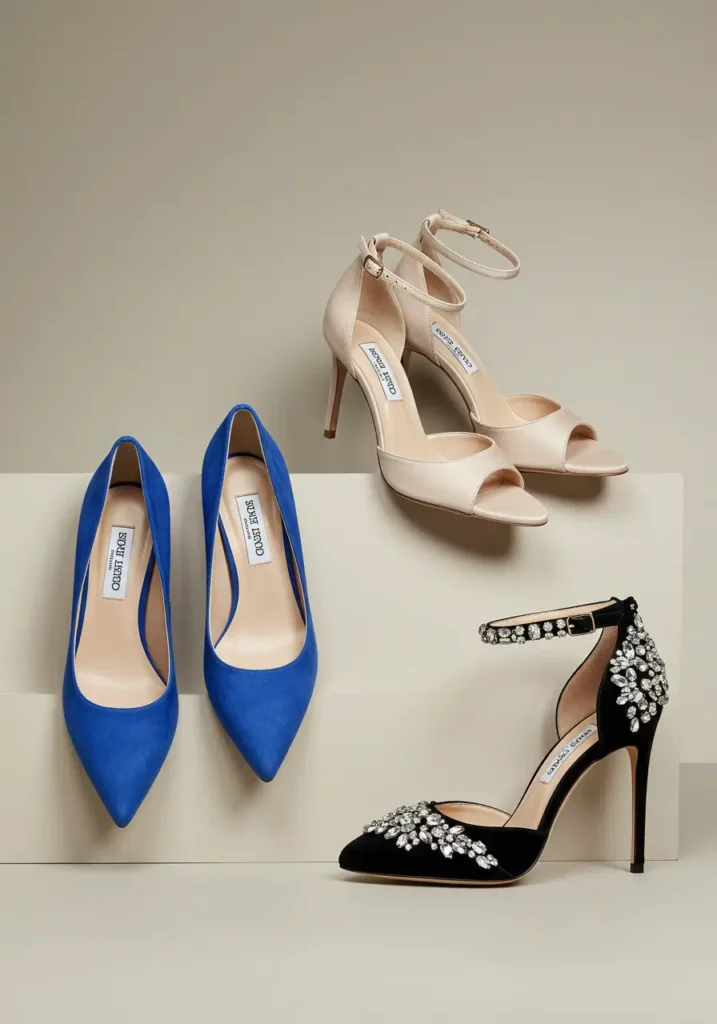
-
UK Relevance: Typically reserved for formal events (weddings, parties, black-tie), specific evening venues, or certain corporate environments where a high level of formality is expected. Less practical for daily wear or commuting.
-
Key Styles: Classic pointed-toe pumps, delicate strappy sandals, embellished evening shoes.
-
Styling: Paired with cocktail dresses, evening gowns, sharp suits, or tailored separates for formal occasions.
-
Personal Style Link: Glamorous, sophisticated, classic formal, bold statement.
Heeled Boots

-
UK Relevance: Combine the coverage and practicality of a boot with the elegance of a heel. Very popular for autumn/winter smart-casual and evening wear. Block heels are common for wearability, but stiletto versions exist.
-
Key Styles: Heeled ankle boots (sock boots, block heel zip boots), heeled knee-high boots.
-
Styling: Elevate jeans-and-knit combos, pair stylishly with midi dresses/skirts, work well with smart trousers.
-
Personal Style Link: Chic, sophisticated, modern, can be edgy depending on the boot style.
5. Sandals and Summer Footwear: Embracing Warmer Days
Though the UK summer is notoriously short and unpredictable, appropriate summer footwear is still needed.
Practical Sandals (Birkenstocks, Teva-style)
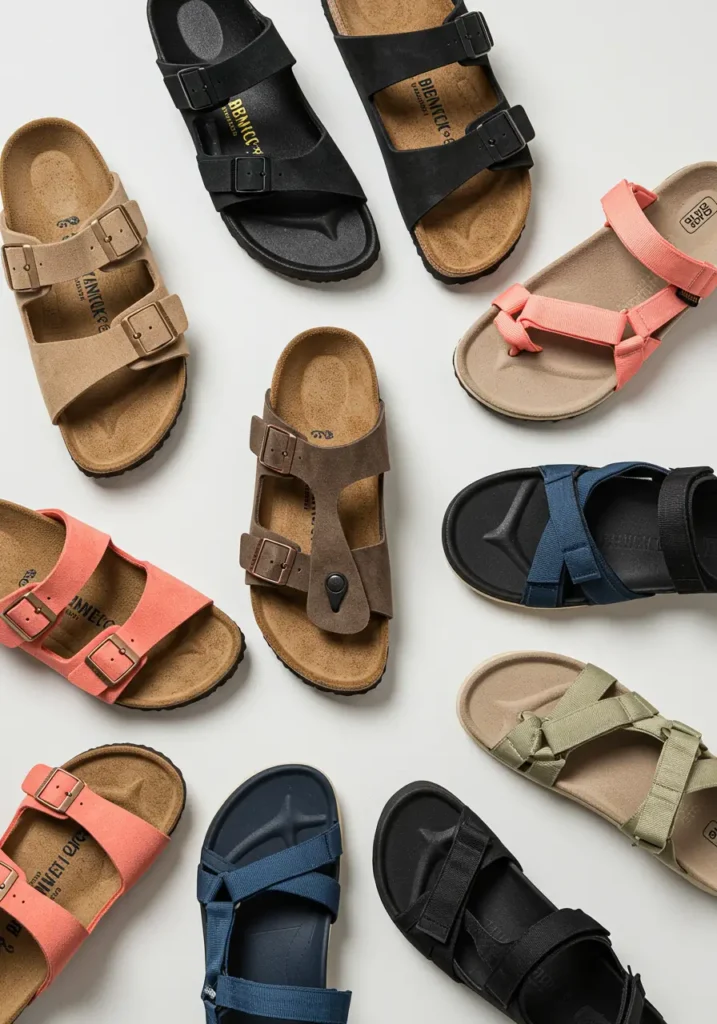
-
UK Relevance: Comfort is key. Birkenstock sandals (especially the Arizona model) and similar comfortable, supportive styles (including Teva-inspired sporty sandals) have become hugely popular for casual summer wear, accepted far beyond their original ‘functional’ purpose. Great for holidays and relaxed weekends. Part of the ongoing ‘ugly shoe’ Shoe Trends that prioritise comfort.
-
Key Styles: Birkenstock Arizona (two-strap), Gizeh (thong), Madrid (single strap). Teva Original Universal or similar strap-based sport sandals. Often in neutral leather, suede, or functional webbing.
-
Styling: Worn casually with shorts, summer dresses, linen trousers, jeans. The juxtaposition of ‘practical’ sandals with slightly dressier items is a common styling trick.
-
Personal Style Link: Relaxed, practical, comfort-focused, slightly bohemian, normcore.
Dressier Sandals (Wedges, Strappy Styles)
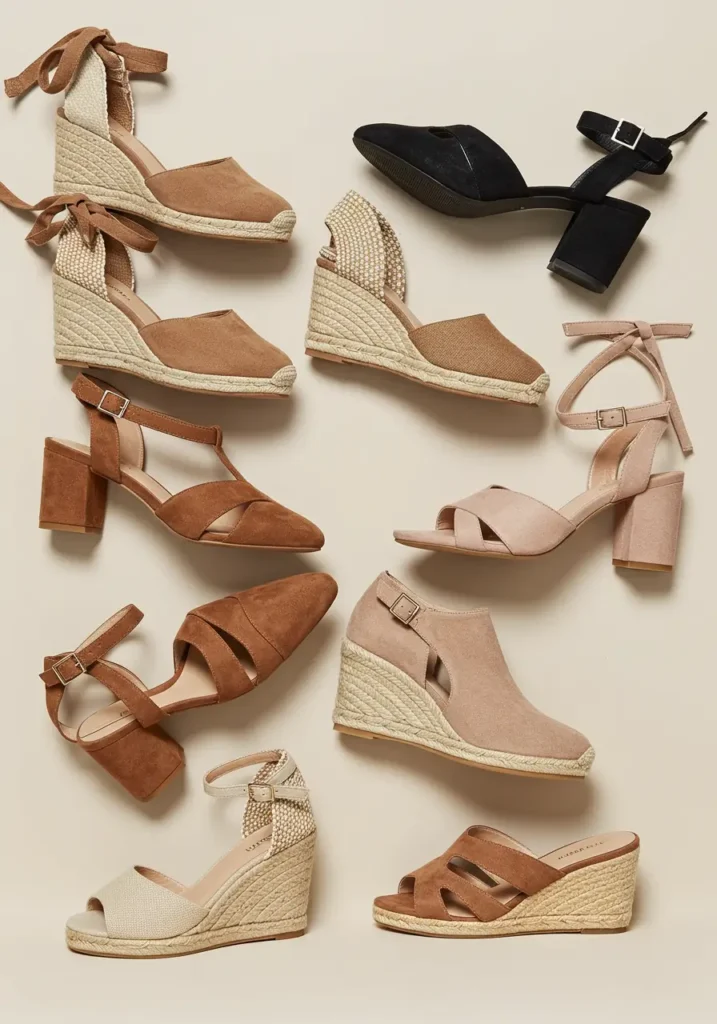
-
UK Relevance: For summer occasions like weddings, garden parties, or evenings out when the weather allows. Wedges offer height with more stability than thin heels, practical for walking on grass.
-
Key Styles: Espadrille wedges (classic summer), block heel sandals, delicate strappy sandals (often heeled). Materials include leather, suede, canvas, raffia.
-
Styling: Paired with summer dresses, skirts, smart shorts, or linen trousers for events or warmer evenings.
-
Personal Style Link: Feminine, summery, chic, glamorous (strappy stilettos).
Espadrilles
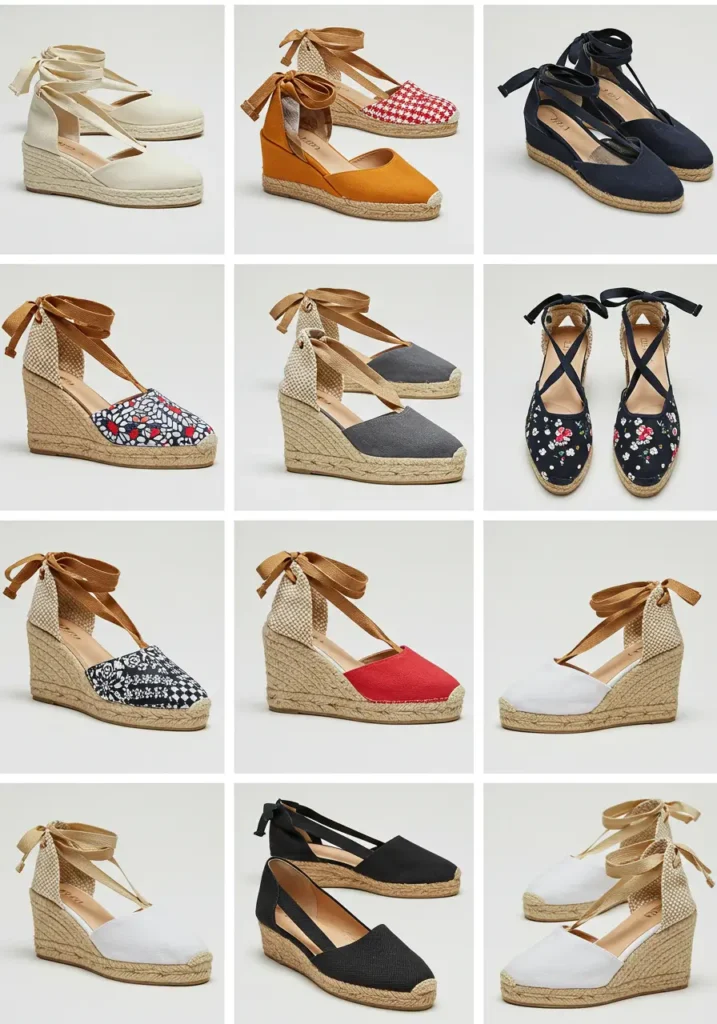
-
UK Relevance: A classic, continental summer shoe adopted for warmer UK days or holidays. Offers a relaxed yet slightly chic feel. Jute soles provide breathability.
-
Key Styles: Flat canvas espadrilles, wedge espadrilles (often with ankle ties). Available in numerous colours and patterns.
-
Styling: Perfect with summer dresses, shorts, cropped trousers, linen. Evokes a holiday or coastal vibe.
-
Personal Style Link: Relaxed, summery, slightly bohemian, classic Riviera chic.
6. The Wellington Boot (‘Wellie’): A UK Icon
No discussion of UK footwear is complete without the humble Wellie.
UK Relevance:** Absolutely essential for navigating muddy fields, rainy festivals, country walks, gardening, and even wet city commutes for some. A practical necessity turned into a style item, particularly through brands like Hunter.
-
Key Styles: Classic Hunter Original Tall (various colours), shorter versions (Chelsea boot style wellies), insulated options for winter, packable versions for travel/festivals. Other brands offer functional or fashion-focused alternatives.
-
Styling: Primarily functional wear with practical trousers/jeans tucked in, often paired with waxed jackets or waterproofs. Became a ‘festival chic’ staple paired (sometimes impractically) with shorts or dresses.
-
Personal Style Link: Practical necessity, country heritage, festival-goer. Colour choice (classic green vs. bright red or glossy black) adds personality.
How Footwear Choices Define Specific Styles in the UK
Your consistent footwear choices are strong indicators of your overall personal style aesthetic. Here is how different styles manifest through shoe selections in a UK context:
Minimalist Style Footwear
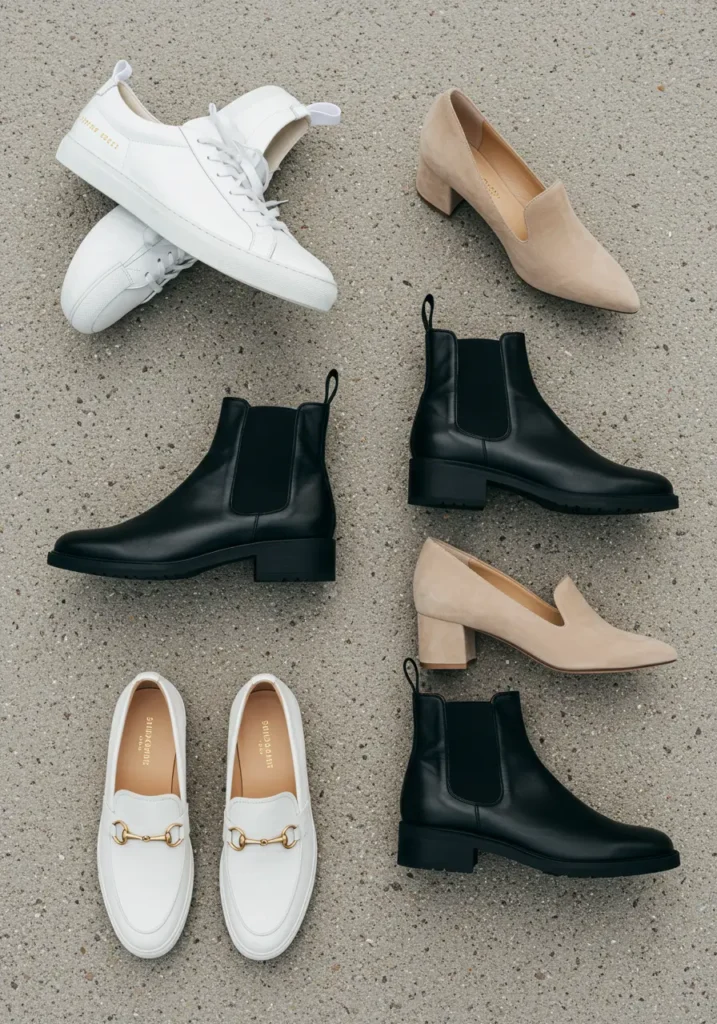
-
Characteristics: Clean lines, neutral colours (white, black, grey, beige), simple silhouettes, lack of excessive embellishment, focus on quality materials.
-
Typical UK Choices: Sleek white leather trainers (Common Projects style), black leather Chelsea boots with a clean profile, minimalist loafers (perhaps horsebit), simple block heel pumps or ankle boots in neutral tones, potentially high-quality minimalist sandals in summer.
Classic Style Footwear
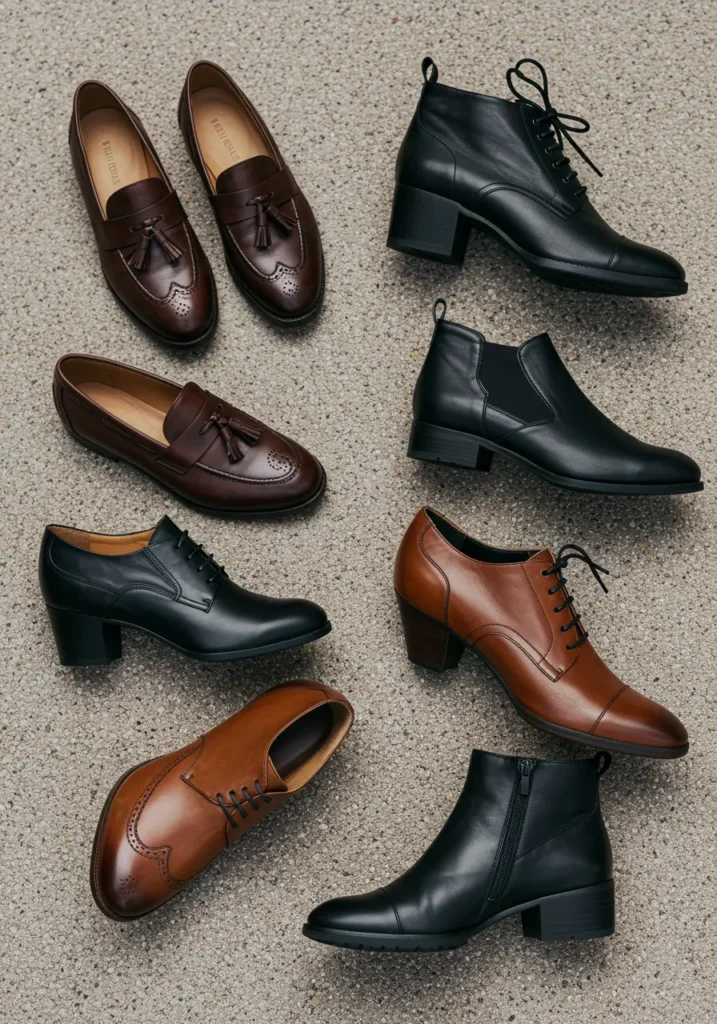
-
Characteristics: Timeless designs, traditional silhouettes, quality leather, neutral colours (black, brown, tan, navy, oxblood), enduring appeal.
-
Typical UK Choices: Leather loafers (penny or tassel), classic brogues or Oxfords, riding boots, simple court shoes (pumps) with a mid-heel, well-made ankle boots (Chelsea or simple zip), classic trench-complementing colours.
Edgy / Alternative Style Footwear
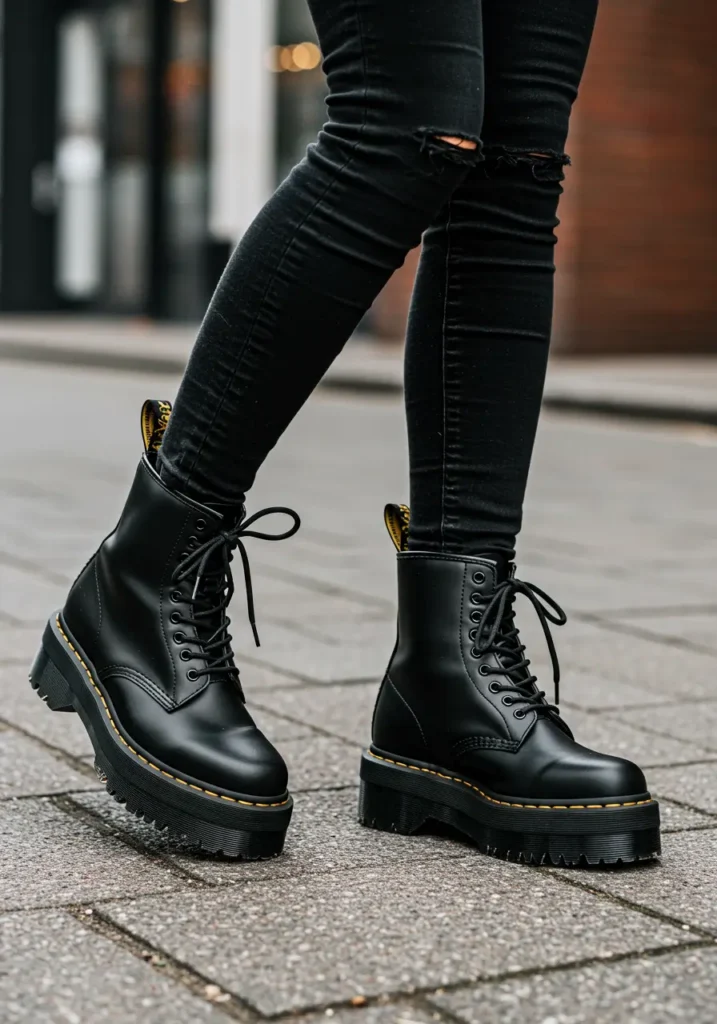
-
Characteristics: Non-conformist designs, often black, chunky soles, hardware (buckles, studs), distressed finishes, links to subcultures.
-
Typical UK Choices: Dr. Martens boots (classic 1460, platform Jadon), combat boots, chunky platform loafers or trainers, specific streetwear trainer models, potentially pointed boots or creepers depending on the specific sub-style.
Bohemian / Relaxed Style Footwear
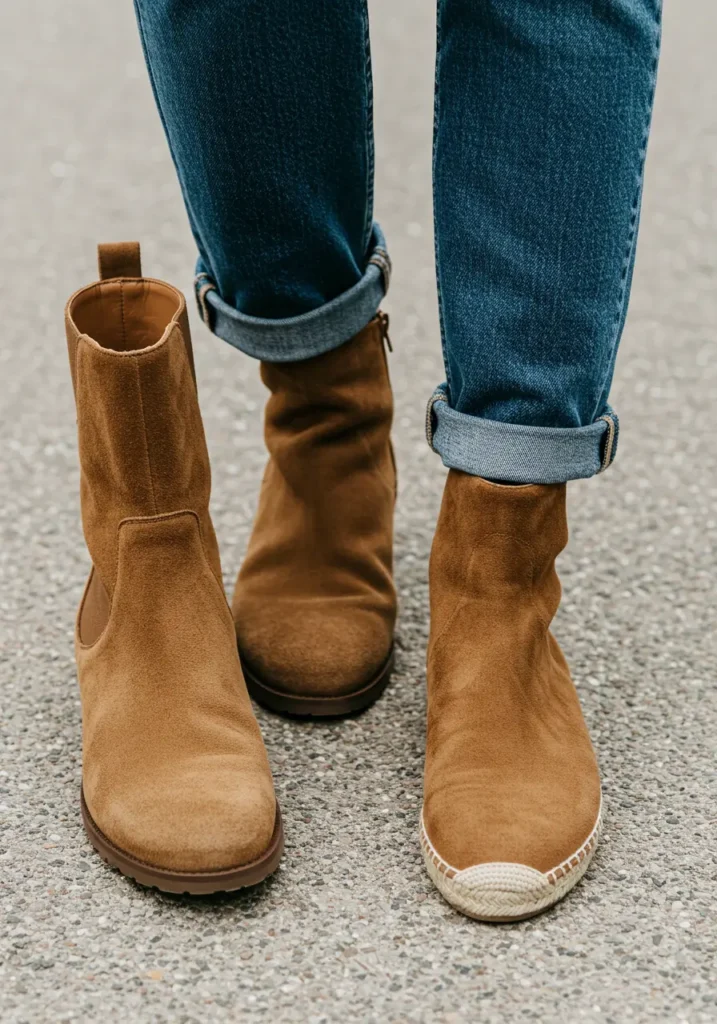
-
Characteristics: Natural materials, earthy tones, comfortable fits, slightly undone feel, focus on texture, artisanal details.
-
Typical UK Choices: Suede ankle boots (tan, brown), Birkenstock sandals, flat leather or woven sandals, espadrilles, slouchy boots, moccasins, potentially sheepskin-lined boots (like Uggs, for casual comfort).
Preppy Style Footwear
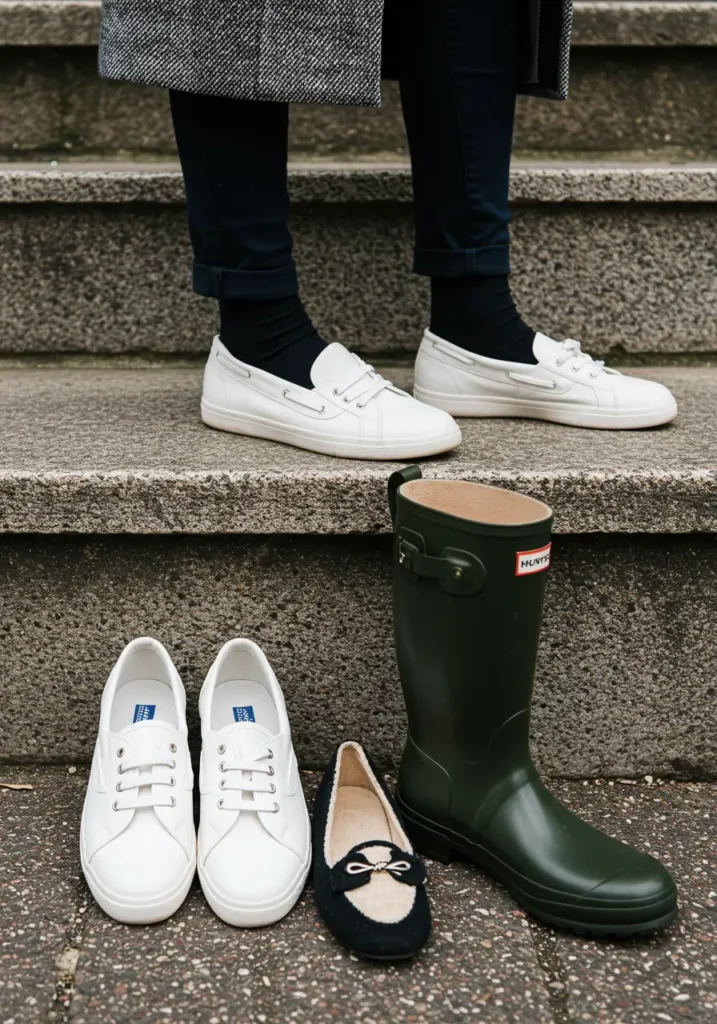
-
Characteristics: Classic, neat, often influenced by collegiate or equestrian heritage, traditional colours (navy, white, tan, red accents).
-
Typical UK Choices: Penny loafers, boat shoes (seasonal), classic white canvas or leather trainers (e.g., Superga, clean Stan Smiths), riding boots, wellies (especially Hunter or Barbour), potentially needlepoint slippers for home/casual.
Sporty / Athleisure Style Footwear
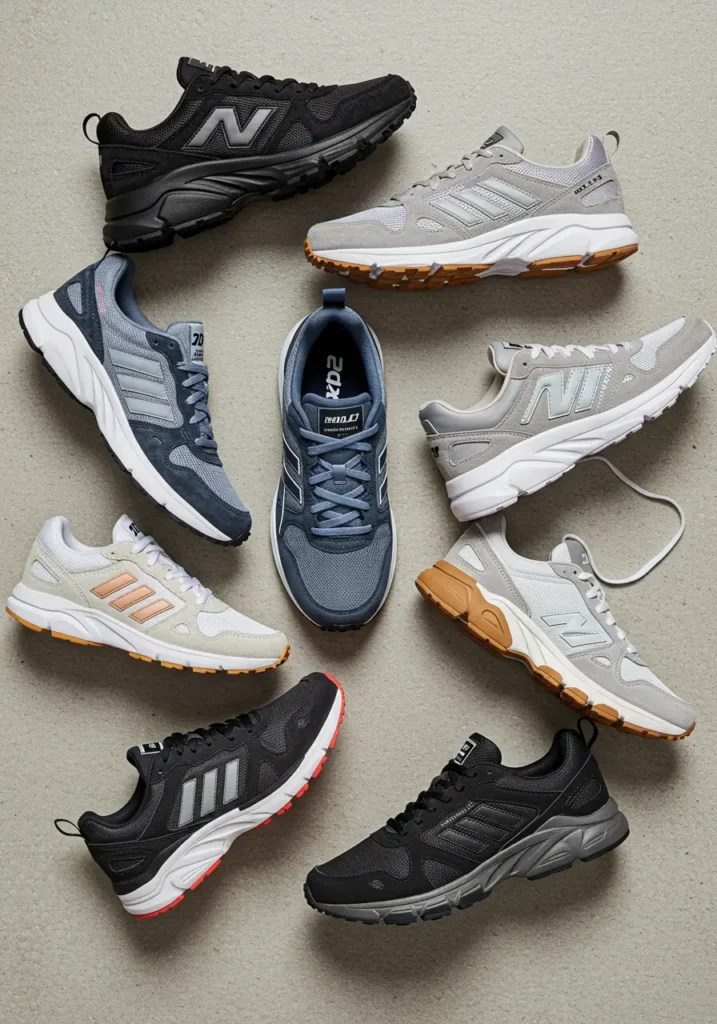
-
Characteristics: Athletic-inspired designs, focus on comfort and performance technology, prominent branding, often colourful or incorporating current Shoe Trends.
-
Typical UK Choices: Fashion trainers from major sportswear brands (Nike Air Max, Adidas Ultraboost, New Balance models), performance running shoes worn as lifestyle items, retro trainer styles, potentially technical sandals in summer.
Understanding these connections helps you select footwear that reinforces your desired personal style message consistently.
Also Read: Top 10 Wardrobe Essentials for Defining Your Personal Style in the UK
Navigating Footwear Trends in the UK: Staying Current, Staying You
The world of footwear fashion UK included, is constantly influenced by evolving Shoe Trends. Engaging with trends can be fun and keep your style feeling current, but it requires a mindful approach to avoid losing your personal style identity or making impractical choices for UK life.
Identifying Current UK Shoe Trends
Stay informed by observing:
-
UK Street Style: What are people actually wearing in cities like London, Manchester, etc.? Look at bloggers, Instagram accounts focusing on UK style.
-
Fashion Weeks (London): See directional trends emerge on the runways.
-
UK Fashion Magazines & Websites: Vogue UK, Elle UK, Stylist, Refinery29 UK often highlight key Shoe Trends.
-
Retail Offerings: Notice recurring themes in high street and designer collections available in the UK.
-
(Note: Specific current trends like chunky loafers, ballet flats revival, specific retro trainers, metallic finishes, platform boots, etc., can be mentioned briefly but avoid dating the article too much.)
Balancing Trends with Personal Style and UK Practicality
Not every trend needs to be adopted. Before buying into a trend, ask:
-
Does it genuinely align with my personal style keywords and aesthetic? Or does it feel forced?
-
Is it practical for my lifestyle and the UK weather? Can I realistically walk comfortably in those? Will they survive a downpour?
-
Does it work with my existing wardrobe? Can I easily create multiple outfits with this trendy shoe?
-
Will I likely wear it beyond one season? Or is it a fleeting micro-trend?
Sometimes a trend can be incorporated subtly – perhaps a trendy colour in a classic silhouette, or a nod to a shape via an accessory.
Investment Pieces vs. Trend-Driven Purchases
-
Invest in high-quality versions of your core essential footwear styles that align with your enduring personal style (e.g., classic leather boots, well-made loafers, versatile trainers). These should last for years.
-
Experiment with trends more cautiously, perhaps via more affordable high street options or secondhand finds, especially if you are unsure about their longevity or how much you will truly wear them. Do not spend a fortune on shoes tied to a very specific, likely short-lived trend unless you absolutely adore them and know they fit your style regardless.
Where to Spot and Shop Trends (UK Context)
-
High Street: Zara, H&M, ASOS, Schuh, Office quickly interpret global trends for the UK market.
-
Mid-Market: Brands like Kurt Geiger, Dune London often balance trends with wearability.
-
Department Stores: Selfridges, Harrods, Liberty, John Lewis showcase a mix of designer and accessible trend pieces.
-
Online: Net-a-Porter, MatchesFashion offer high-end trend perspectives.
Building Your UK Footwear Wardrobe: Practical Tips
Creating a functional and expressive footwear collection takes time and intention. Here are some final tips focused on footwear fashion UK realities:
Reassess Your Lifestyle & Needs Annually
Your life changes, and so might your footwear needs. Re-evaluate annually: What activities do I now do most? What gaps exist? What shoes go unworn and why?
Prioritize Your Core Essentials First
Focus on acquiring good quality versions of the 3-5 most essential footwear categories for your specific life within the UK context (likely including a waterproof boot, a comfortable trainer, and a smart flat/loafer). Build outwards from there.
Never Compromise on Comfort (Especially for Everyday Wear)
Ill-fitting shoes are miserable and unhealthy. Prioritise comfort and proper fit, particularly for shoes you will wear frequently for walking or standing. Remember UK sizes differ from EU/US sizes – always try shoes on, preferably later in the day when feet might be slightly swollen. Walk around the shop.
Quality Construction Matters (Cost-Per-Wear)
Invest in well-made shoes, especially for boots and everyday styles. Look for quality leather (or durable alternatives), sturdy stitching, and well-attached, durable soles. Better quality may cost more initially but lasts longer, looks better, and offers better value per wear.
Consider UK Retailers and Secondhand Options
Support British brands and independent shoe shops where possible. Explore the vast secondhand market (charity shops, Vinted, Depop, eBay UK) for high-quality shoes at lower prices – a sustainable and budget-friendly approach popular in the UK.
Shoe Care is Non-Negotiable for Longevity
Protect your investment, especially given the UK weather:
-
Weatherproof: Apply protector sprays to leather and suede regularly.
-
Clean Regularly: Wipe off dirt and mud promptly. Use appropriate cleaners for different materials.
-
Condition Leather: Keep leather supple with conditioner to prevent cracking.
-
Use Shoe Trees: Help leather shoes maintain their shape.
-
Repair: Find a local UK cobbler (shoe repairer) for resoling, heel tip replacement, and other repairs – extending the life of quality shoes significantly.
Conclusion: Finding Your Feet in Style
Footwear is far more than a footnote in the story of personal style; it is a defining chapter. Within the specific context of footwear fashion UK, our choices reflect a unique blend of navigating practical demands – the weather, the walking, the lifestyle – while embracing a rich heritage and interpreting global Shoe Trends.
From the steadfast reliability of a sturdy boot or classic loafer to the contemporary cool of a white trainer or the expressive statement of a unique heel, your shoes anchor your look and communicate volumes about who you are. By understanding the role footwear plays, identifying the categories most relevant to UK life, aligning choices with your authentic self, and building your collection mindfully with a focus on quality, comfort, and versatility, you can create a footwear wardrobe that not only serves you practically but empowers you to step out with confidence and style every single day.
Let your shoes be a conscious choice, a joyful expression, and a solid foundation for your personal style journey.
FAQs About Footwear and Personal Style UK
What are the absolute ‘must-have’ shoes if I’m building a minimal wardrobe for the UK?
- For a truly minimal UK wardrobe, prioritise maximum versatility and weather appropriateness:
-
A durable, comfortable Ankle Boot (e.g., leather Chelsea or lace-up) – handles most weather, dresses up or down.
-
A comfortable Trainer (e.g., classic white leather or a versatile retro style) – for casual wear, walking, commuting.
A Smart Flat Shoe (e.g., Loafer or pointed flat) – for work or smarter occasions where boots/trainers aren’t suitable.These three cover a wide range of typical UK scenarios. Add a practical waterproof boot (like a Wellie or hiking style) if your lifestyle requires it.
How important is matching shoes to bags in UK fashion today?
The strict rule of matching shoes and bags precisely is largely outdated in contemporary UK fashion. While coordinating tones or materials can create a cohesive look, it’s no longer considered essential. Modern style often embraces intentional contrasts or allows the bag and shoes to be interesting pieces in their own right, complementing the overall outfit without needing to match exactly. Focus on whether the items work with the outfit and your overall style rather than just each other.
With UK weather being so unpredictable, how do I choose footwear for transitional seasons like spring and autumn?
This is where versatility is key. Ankle boots are prime transitional footwear. Loafers and classic trainers also work well. Layering socks can extend the wear of trainers and loafers into cooler days. Having reliable water-resistant options (treated leather boots, practical trainers) is crucial. Avoid fully summery open sandals or heavy winter-only boots during these in-between months. Focus on closed-toe styles and materials that can handle a potential shower.
Are expensive shoe brands worth the investment for UK wear and tear?
Often, yes, if you choose wisely. Investing in well-constructed shoes from reputable brands known for quality materials and durability (especially those using methods like Goodyear welting, common in traditional UK shoemaking) can be cost-effective long-term. Quality leather, sturdy soles, and repairability mean they can withstand UK weather and walking better and last significantly longer than cheaper alternatives, reducing cost-per-wear. Focus investment on essential, timeless styles you’ll wear frequently (like boots, loafers, classic trainers) rather than fleeting Shoe Trends.
How can I incorporate more colour into my footwear choices without it feeling overwhelming or impractical for UK style?
Start subtly. Instead of bright primary colours, consider richer jewel tones (emerald green, deep burgundy, sapphire blue) or earthy hues (mustard yellow, terracotta, olive) which often feel more grounded in the UK palette. Introduce colour via:
-
Trainers: A classic silhouette with colourful accents or a full colour block.
-
Loafers or Flats: A coloured suede loafer or velvet flat adds personality.
-
Boots: Burgundy or deep green boots can be surprisingly versatile alternatives to black or brown.
-
Occasion Shoes: Heels or sandals for events are a great place for bolder colour.
-
Ensure the colour complements your core wardrobe palette for easier styling.
